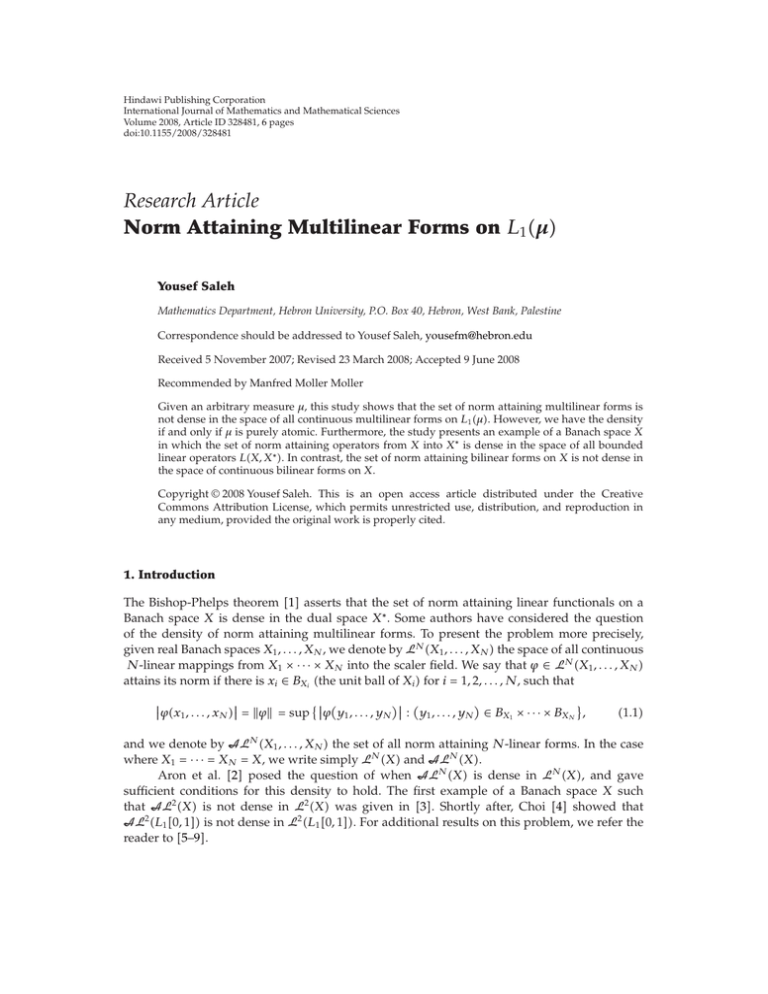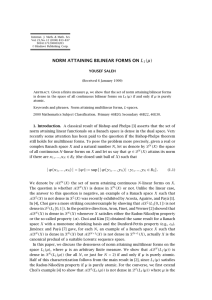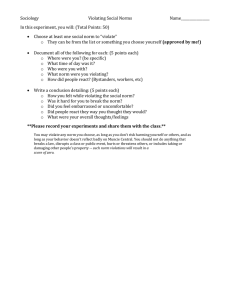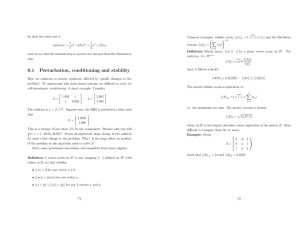Document 10450603
advertisement

Hindawi Publishing Corporation
International Journal of Mathematics and Mathematical Sciences
Volume 2008, Article ID 328481, 6 pages
doi:10.1155/2008/328481
Research Article
Norm Attaining Multilinear Forms on L1µ
Yousef Saleh
Mathematics Department, Hebron University, P.O. Box 40, Hebron, West Bank, Palestine
Correspondence should be addressed to Yousef Saleh, yousefm@hebron.edu
Received 5 November 2007; Revised 23 March 2008; Accepted 9 June 2008
Recommended by Manfred Moller Moller
Given an arbitrary measure μ, this study shows that the set of norm attaining multilinear forms is
not dense in the space of all continuous multilinear forms on L1 μ. However, we have the density
if and only if μ is purely atomic. Furthermore, the study presents an example of a Banach space X
in which the set of norm attaining operators from X into X ∗ is dense in the space of all bounded
linear operators LX, X ∗ . In contrast, the set of norm attaining bilinear forms on X is not dense in
the space of continuous bilinear forms on X.
Copyright q 2008 Yousef Saleh. This is an open access article distributed under the Creative
Commons Attribution License, which permits unrestricted use, distribution, and reproduction in
any medium, provided the original work is properly cited.
1. Introduction
The Bishop-Phelps theorem 1 asserts that the set of norm attaining linear functionals on a
Banach space X is dense in the dual space X ∗ . Some authors have considered the question
of the density of norm attaining multilinear forms. To present the problem more precisely,
given real Banach spaces X1 , . . . , XN , we denote by LN X1 , . . . , XN the space of all continuous
N-linear mappings from X1 × · · · × XN into the scaler field. We say that ϕ ∈ LN X1 , . . . , XN attains its norm if there is xi ∈ BXi the unit ball of Xi for i 1, 2, . . . , N, such that
ϕx1 , . . . , xN ϕ sup ϕ y1 , . . . , yN : y1 , . . . , yN ∈ BX × · · · × BX ,
1
N
1.1
and we denote by ALN X1 , . . . , XN the set of all norm attaining N-linear forms. In the case
where X1 · · · XN X, we write simply LN X and ALN X.
Aron et al. 2 posed the question of when ALN X is dense in LN X, and gave
sufficient conditions for this density to hold. The first example of a Banach space X such
that AL2 X is not dense in L2 X was given in 3. Shortly after, Choi 4 showed that
AL2 L1 0, 1 is not dense in L2 L1 0, 1. For additional results on this problem, we refer the
reader to 5–9.
2
International Journal of Mathematics and Mathematical Sciences
In this paper, we give some improvements on the results in 10. More concretely, it was
shown in that study that given an arbitrary finite measure μ, AL2 L1 μ is dense in L2 L1 μ
if and only if μ is purely atomic. In this note, we extend the above result to an arbitrary measure.
Namely, we proved that, given any arbitrary measure μ, ALN L1 μ is dense in LN L1 μ if
and only if μ is purely atomic. Also, we present a new example of a Banach space X such that
the set of norm attaining operators from X into X ∗ is dense in the space of all bounded linear
operators from X into X ∗ , but the set AL2 X is not dense in L2 X. This can be shown by
relating the main result in our work to the following theorem.
Theorem 1.1 see 11, Theorem 1. Given an arbitrary measure μ and a localizable measure ν, the
set of norm attaining operators from L1 μ into L∞ ν is dense in the space LL1 μ, L∞ ν.
2. The results
We begin by recalling the isometric classification of L1 -spaces and a technical lemma which
deals with the density of norm attaining bilinear forms on arbitrary l1 -sums of Banach spaces
in order to reduce the proof of our problem to the case where μ is a finite measure. Recall that
if μ is an arbitrary measure, L1 μ can be decomposed in the form
L1 μ ∼
⊕i∈I L1 μi 1
2.1
where μi is a finite measure for all i ∈ I see, e.g., 12, Appendix B. On the other hand, if
ν is a localizable measure we have that L∞ ν L1 ν∗ , and we get a set of finite measures
{νj : j ∈ J} such that
L∞ ν ∼
⊕j∈J L∞ νj ∞ .
2.2
In what follows, we may assume without loss of generality that Ω, A, μ is a finite measure
space. The well-known representation of the space L2 L1 μ is nothing but L∞ μ ⊗ μ “the
space of all essential bounded measurable functions,” where μ⊗μ denotes the product measure
on Ω × Ω. More concretely,
∗
L2 L1 μ ∼
L∞ μ ⊗ μ;
L L1 μ, L∞ μ ∼
L L1 μ, L1 μ ∼
2.3
see 12, Example 3.27 . In view of the above, we get the integral representation for the
on L2 L1 μ as follows:
continuous bilinear form h
hf, g hx, yfxgydμxdμy,
2.4
Ω×Ω
is linear isometric
for f, g ∈ L1 μ, x, y ∈ Ω, and h ∈ L∞ μ⊗μ. Moreover, the application h → h
bijection from L∞ μ ⊗ μ onto L2 L1 μ; see 4.
To make the vision more comprehensive, we state the following technical lemmas that
will be needed later. To simplify the notation, we consider the case N 2. The proof for the
general case is exactly the same.
Lemma 2.1 see 10, Lemma 2.1. Let ν be an arbitrary nonzero finite measure and μ ν ⊗ m, where
m denotes Lebesgue measure on I 0, 1. Then AL2 L1 μ is not dense in L2 L1 μ.
Yousef Saleh
3
The other technical lemma deals with l1 -sums of Banach spaces. By Y ⊕1 Z we denote the
1 -sum of two Banach spaces Y and Z, that is, y z y z for arbitrary y ∈ Y , z ∈ Z.
Lemma 2.2 see 10, Lemma 2.2. Let Y, Z be Banach spaces and X Y ⊕1 Z. If AL2 X is dense
in L2 X, then AL2 Y is dense in L2 Y .
Our first result of this paper is a characterization of those functions h ∈ L∞ μ ⊗ μ, where
its corresponding bilinear form in L2 L1 μ that attains its norm see 4.
h
be its
Proposition 2.3. Let Ω, A, μ be a finite measure space, fixed h ∈ L∞ μ ⊗ μ, and let h
corresponding bilinear form as defined in 2.4
1 There exist sets A, B ∈ A with μA > 0, μB > 0 and a scalar t with |t| 1 such that
thx, y h∞
2.5
for μ ⊗ μ-almost every x, y ∈ A × B.
2 There are sets A, B like in (1) and measurable functions ϕ, ψ on Ω such that
ϕw ψw 1,
2.6
where w ∈ Ω and ϕxψyhx, y h∞ , for μ ⊗ μ-almost every x, y ∈ A × B.
∈ L2 L1 μ corresponding to h ∈ L∞ μ ⊗ μ attains its norm.
3 The bilinear form h
Then 1 ⇒ 2 ⇐⇒ 3.
2.7
Moreover, in the real case all three statements are equivalent.
Proof. 1 ⇒ 2 is clear, just take ϕ t and ψ 1.
For 2 ⇒ 3, just consider the functions f ϕχA /μA, g ψχA /μB where f, g are
in the unit sphere of L1 μ, χA , χB denote the characteristic functions on A and B, respectively,
and
1
1
hf, g hx, yϕxψydμxdμy h∞ dμ ⊗ μ h∞ .
μAμB A×B
μAμB A×B
2.8
g h . Take
3 ⇒ 2 Let f, g ∈ L1 μ be such that f1 g1 1 and hf,
∞
A x ∈ Ω : fx /
0 ,
B y ∈ Ω : gy /
0
2.9
to be two measurable sets in Ω with μA > 0, μB > 0, and write f, g in the forms f ϕ|f|, g ψ|g| where ϕ, ψ are measurable functions on Ω with |ϕ| 1, |ψ| 1, then we have
g h∞ hf,
A×B
hx, yϕxfxψygydμxdμy ≤ h∞ f1 g1 h∞ ,
2.10
4
International Journal of Mathematics and Mathematical Sciences
from which we conclude that
hx, yϕxψy h∞
2.11
for μ ⊗ μ-almost every x, y ∈ A × B.
In the real case, the functions ϕ, ψ have only the values ±1, then we can choose
measurable subsets A0 ⊆ A and B0 ⊆ B such that μA0 μB0 > 0, where ϕ, ψ are constants
on A0 , B0 , respectively. If t ±1 is the product of these constants, then we have clearly
thx, y h∞ for μ ⊗ μ-almost every x, y ∈ A0 × B0 , so we get that 3 ⇒ 1, as
required.
In the special case h χE , the characteristic function of a measurable set E ∈ A × A, we
have the following result.
Corollary 2.4. Let Ω, A, μ be a finite measure space, let E ∈ A × A be a measurable set with μ ⊗
μE > 0, and consider the following bilinear form χE corresponding to the characteristic function of
E. The following statements are equivalent:
1 χE ∈ AL2 L1 μ;
2 χE ∈ AL2 L1 μ;
3 There exist subsets A, B ∈ A with μAμB > 0 such that μ⊗μA×B∩E μAμB.
Note that we can say that the measurable rectangle A × B is contained in the set E.
Proof. 1 ⇒ 2. This is trivial.
∈ AL2 L1 μ,
2 ⇒ 3. Let h ∈ L∞ μ ⊗ μ be such that χE − h∞ < 1/2, and h
then it is clear that h∞ > 1/2. From the implication 3 ⇒ 2 of Proposition 2.3 , we have
two measurable sets A, B ∈ A with μAμB > 0, and measurable functions ϕ, ψ on Ω with
|ϕx| |ψy| 1, such that
ϕxψyhx, y h∞ ,
2.12
hx, y h > 1 ,
∞
2
2.13
then
for μ ⊗ μ-almost every x, y ∈ A × B. Hence
χE x, y ≥ hx, y − hx, y − χE x, y > 1 − h − χE > 0.
∞
2
2.14
for μ ⊗ μ-almost every x, y ∈ A × B, from which we get that χE 1, for μ ⊗ μ-almost every
x, y ∈ A × B, which means that 3 holds.
3 ⇒ 1. If A, B are the sets that satisfy the conditions of the statement 3, then we
may clearly see that the function χE 1 χE ∞ , for μ ⊗ μ-almost every x, y ∈ A × B, then
the function f χE verifies the statement 1 of Proposition 2.3 including the case t 1.
Yousef Saleh
5
Remark 2.5. Let us point out the following consequence of the representation theory for L1 spaces. Indeed, if ν is a finite measure, we may write
L1 ν ⊕iI Xi 1 ,
2.15
where each space Xi is either 1-dimensional or of the form L1 0, 1Λ and Λ is a finite or infinite
set. For each coordinate interval, we consider the Lebesgue measure on the Borel subsets of
0, 1 and 0, 1Λ provided with the product measure on the Borel σ-algebra see 13.
We are now ready to provide the main result.
Theorem 2.6. Given an arbitrary measure μ, the following statements are equivalents.
1 μ is purely atomic.
2 ALN L1 μ is dense in LN L1 μ for any number N.
3 ALN L1 μ is dense in LN L1 μ for any number N ≥ 2.
4 AL2 L1 μ is dense in L2 L1 μ.
Proof. 1 ⇒ 2. If μ is purely atomic, then L1 μ has the Radon-Nikodym property, and 2
follows from 2, Theorem 1.
2 ⇒ 3. This is trivial.
3 ⇒ 4. This follows from 8, Proposition 2.1.
4 ⇒ 1. Given an arbitrary nonempty set Λ, consider the product 0, 1Λ of so many
copies of 0, 1 as indicated by Λ with product measure. We have clearly μ ν ⊗ m, where
ν is an arbitrary nonzero finite measure and m denotes the Lebesgue measure on 0, 1. Then
it follows form Lemma 2.1 that AL2 L1 0, 1Λ is not dense in L2 L1 0, 1Λ . Indeed, if μ is
a finite measure satisfying statement 4 of the above theorem, then by Remark 2.5, L1 μ ∼
Λi
⊕i∈I Xi 1 for each i ∈ I, where Xi is 1-dimensional or of the form L1 0, 1 for appropriate
nonempty set Λi see 13, Theorem 14. It follows then from Lemma 2.2 that AL2 Xi is dense
in L2 Xi for all i ∈ I. But in view of Remark 2.5, none of the spaces Xi are of the form L1 0, 1Λi .
Then all Xi are 1-dimensional, and then L1 μ ∼
1 I, which means that μ is purely atomic.
Finally, if μ is not necessarily a finite measure satisfying 4 of our theorem, we recall that
L1 μ ∼
⊕i∈I L1 μi 1 , where μi is a finite measure for all i ∈ I. So by Lemma 2.2, we get that
AL2 L1 μi is dense in L2 L1 μi , and this proves that μi is purely atomic for each i ∈ I,
which clearly means that μ is purely atomic.
Remark 2.7. Let us mention the relation between the L2 X, the space of all continuous bilinear
forms on the Banach space X, and LX, X ∗ , the space of all bounded linear operators from
X into X ∗ , to see that just consider the canonical identification of L2 X with LX, X ∗ . The
operator T ∈ LX, X ∗ corresponding to a bilinear form ϕ ∈ L2 X is given by
T xy ϕx, y
x, y ∈ X.
2.16
The bilinear form ϕ attains its norm if and only if the operator T attains its norm at a point
x ∈ BX , that is, T x also attains its norm as a functional on X, therefore, T ∈ NAX, X ∗ whenever ϕ ∈ ALN X, but the converse is not true see 4, 14, 15. Connecting our main
result in this paper with Theorem 1.1, we get a new example of a Banach space X such that
the set of norm attaining bounded linear operators from X into X ∗ is dense in the space of all
bounded linear operators from X into X ∗ , but AL2 X is not dense in L2 X.
6
International Journal of Mathematics and Mathematical Sciences
Therefore, the following result is inevitable.
Corollary 2.8. If μ is a localizable and not purely atomic measure, then the set of norm attaining
bounded linear operators from L1 μ into L∞ μ is dense in the space LL1 μ, L∞ μ but
AL2 L1 μ is not dense in L2 L1 μ.
References
1 E. Bishop and R. R. Phelps, “A proof that every Banach space is subreflexive,” Bulletin of the American
Mathematical Society, vol. 67, pp. 97–98, 1961.
2 R. M. Aron, C. Finet, and E. Werner, “Some remarks on norm-attaining n-linear forms,” in Function
Spaces, K. Jarosz, Ed., vol. 172 of Lecture Notes in Pure and Applied Mathematics, pp. 19–28, Marcel
Dekker, New York, NY, USA, 1995.
3 M. D. Acosta, F. J. Aguirre, and R. Payá, “There is no bilinear Bishop-Phelps theorem,” Israel Journal of
Mathematics, vol. 93, pp. 221–227, 1996.
4 Y. S. Choi, “Norm attaining bilinear forms on L1 0, 1,” Journal of Mathematical Analysis and
Applications, vol. 211, no. 1, pp. 295–300, 1997.
5 M. D. Acosta, “On multilinear mappings attaining their norms,” Studia Mathematica, vol. 131, no. 2,
pp. 155–165, 1998.
6 J. Alaminos, Y. S. Choi, S. G. Kim, and R. Payá, “Norm attaining bilinear forms on spaces of continuous
functions,” Glasgow Mathematical Journal, vol. 40, no. 3, pp. 359–365, 1998.
7 Y. S. Choi and S. G. Kim, “Norm or numerical radius attaining multilinear mappings and
polynomials,” Journal of the London Mathematical Society, vol. 54, no. 1, pp. 135–147, 1996.
8 M. Jiménez Sevilla and R. Payá, “Norm attaining multilinear forms and polynomials on preduals of
Lorentz sequence spaces,” Studia Mathematica, vol. 127, no. 2, pp. 99–112, 1998.
9 R. Payá and Y. Saleh, “New sufficient conditions for the denseness of norm attaining multilinear
forms,” Bulletin of the London Mathematical Society, vol. 34, no. 2, pp. 212–218, 2002.
10 Y. Saleh, “Norm attaining bilinear forms on L1 μ,” International Journal of Mathematics and
Mathematical Sciences, vol. 23, no. 12, pp. 833–837, 2000.
11 R. Payá and Y. Saleh, “Norm attaining operators from L1 μ into L∞ ν,” Archiv der Mathematik, vol.
75, no. 5, pp. 380–388, 2000.
12 A. Defant and K. Floret, Tensor Norms and Operator Ideals, vol. 176 of North-Holland Mathematics Studies,
North-Holland, Amsterdam, The Netherlands, 1993.
13 H. E. Lacey, The Isometric Theory of Classical Banach Spaces, Springer, New York, NY, USA, 1974.
14 C. Finet and R. Payá, “Norm attaining operators from L1 into L∞ ,” Israel Journal of Mathematics, vol.
108, pp. 139–143, 1998.
15 R. Payá, “Norm attaining operators versus bilinear forms,” Extracta Mathematicae, vol. 12, no. 2, pp.
179–183, 1997.









